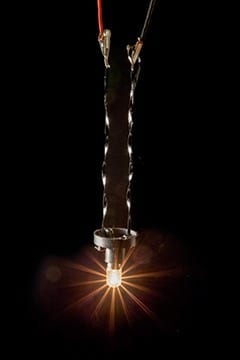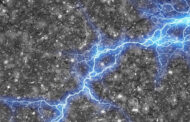Researchers at Linköping University’s Laboratory of Organic Electronics, Sweden, have developed power paper – a new material with an outstanding ability to store energy. The material consists of nanocellulose and a conductive polymer. The results have been published in Advanced Science.
One sheet, 15 centimetres in diameter and a few tenths of a millimetre thick can store as much as 1 F, which is similar to the supercapacitors currently on the market. The material can be recharged hundreds of times and each charge only takes a few seconds.
It’s a dream product in a world where the increased use of renewable energy requires new methods for energy storage – from summer to winter, from a windy day to a calm one, from a sunny day to one with heavy cloud cover.
”Thin films that function as capacitors have existed for some time. What we have done is to produce the material in three dimensions. We can produce thick sheets,” says Xavier Crispin, professor of organic electronics and co-author to the article just published in Advanced Science.
Other co-authors are researchers from KTH Royal Institute of Technology, Innventia, Technical University of Denmark and the University of Kentucky.
The material, power paper, looks and feels like a slightly plasticky paper and the researchers have amused themselves by using one piece to make an origami swan – which gives an indication of its strength.
The structural foundation of the material is nanocellulose, which is cellulose fibres which, using high-pressure water, are broken down into fibres as thin as 20 nm in diameter. With the cellulose fibres in a solution of water, an electrically charged polymer (PEDOT:PSS), also in a water solution, is added. The polymer then forms a thin coating around the fibres.
”The covered fibres are in tangles, where the liquid in the spaces between them functions as an electrolyte,” explains Jesper Edberg, doctoral student, who conducted the experiments together with Abdellah Malti, who recently completed his doctorate.
The new cellulose-polymer material has set a new world record in simultaneous conductivity for ions and electrons, which explains its exceptional capacity for energy storage. It also opens the door to continued development toward even higher capacity. Unlike the batteries and capacitors currently on the market, power paper is produced from simple materials – renewable cellulose and an easily available polymer. It is light in weight, it requires no dangerous chemicals or heavy metals and it is waterproof.
The Power Papers project has been financed by the Knut and Alice Wallenberg Foundation since 2012.
”They leave us to our research, without demanding lengthy reports, and they trust us. We have a lot of pressure on us to deliver, but it’s ok if it takes time, and we’re grateful for that,” says Professor Magnus Berggren, director of the Laboratory of Organic Electronics at Linköping University.
Read more: Storing electricity in paper
The Latest on: Power Paper
[google_news title=”” keyword=”Power Paper” num_posts=”10″ blurb_length=”0″ show_thumb=”left”]
via Google News
The Latest on: Power Paper
- Decoding International Paper Co (IP): A Strategic SWOT Insighton April 26, 2024 at 10:04 pm
International Paper Co ( NYSE:IP) maintains a strong foothold in the North American corrugated packaging market. Recent divestitures and strategic focus on profitable segments position IP for ...
- Polish opposition lawmaker's phone was hacked while party was in power, paper reportson April 26, 2024 at 11:13 am
A lawmaker from Poland's former ruling party is among 31 people prosecutors have summoned because they were victims of phone hacking while the party was in power, Gazeta Wyborcza daily reported on ...
- Fire shuts down Linwood paper planton April 26, 2024 at 2:41 am
CINCINNATI (WXIX) Fire broke out inside a large cardboard paper processing plant in Linwood, prompting crews to shut all power down, according to the Cincinnati Fire Department. Firefighters responded ...
- Is Ryan Smith now a power broker in the sports industry?on April 25, 2024 at 8:34 pm
Berri said while it’s unique for a sports franchise owner to have four teams, he doesn’t know if that makes Smith a power broker. But he does have some thoughts about why multibillionaires buy ...
- New Pollution Regulations Could Largely Eliminate Coal Power by the 2030son April 25, 2024 at 1:00 pm
The EPA has released four new pollution rules, most focusing on coal-fired power, as the final pieces of Biden’s push to clean up the power sector ...
- New Membrane Technology Converts Saltwater Gradients into Poweron April 25, 2024 at 9:23 am
In a recent paper published in the journal ACS Energy Letters, researchers from the Anhui Agricultural University and Guangxi University developed a semipermeable membrane that captures and transforms ...
- Nintendo’s new Paper Mario remaster doesn’t mess with perfectionon April 25, 2024 at 6:00 am
Paper Mario: The Thousand-Year Door is a peak Mario RPG, and that likely won’t be changing ...
- Fallout 4 best Power Armor ranked and all locationson April 24, 2024 at 2:06 am
Here is a list of the best Fallout Power Armor sets ranked from worst to best and all Power Armor locations in the game.
- Why Losing Political Power Now Feels Like ‘Losing Your Country’on April 23, 2024 at 10:03 pm
It is difficult, if not impossible, to attempt to counter polarization at a time when partisan sectarianism is intense and pervasive.
- Maximizing Power Grid Securityon April 23, 2024 at 10:59 am
Regardless of motive and intent, future energy grid planning—and the planning of all cyber-physical systems for that matter—are destined to use AI as a foundation for optimization, according to PNNL, ...
via Bing News








